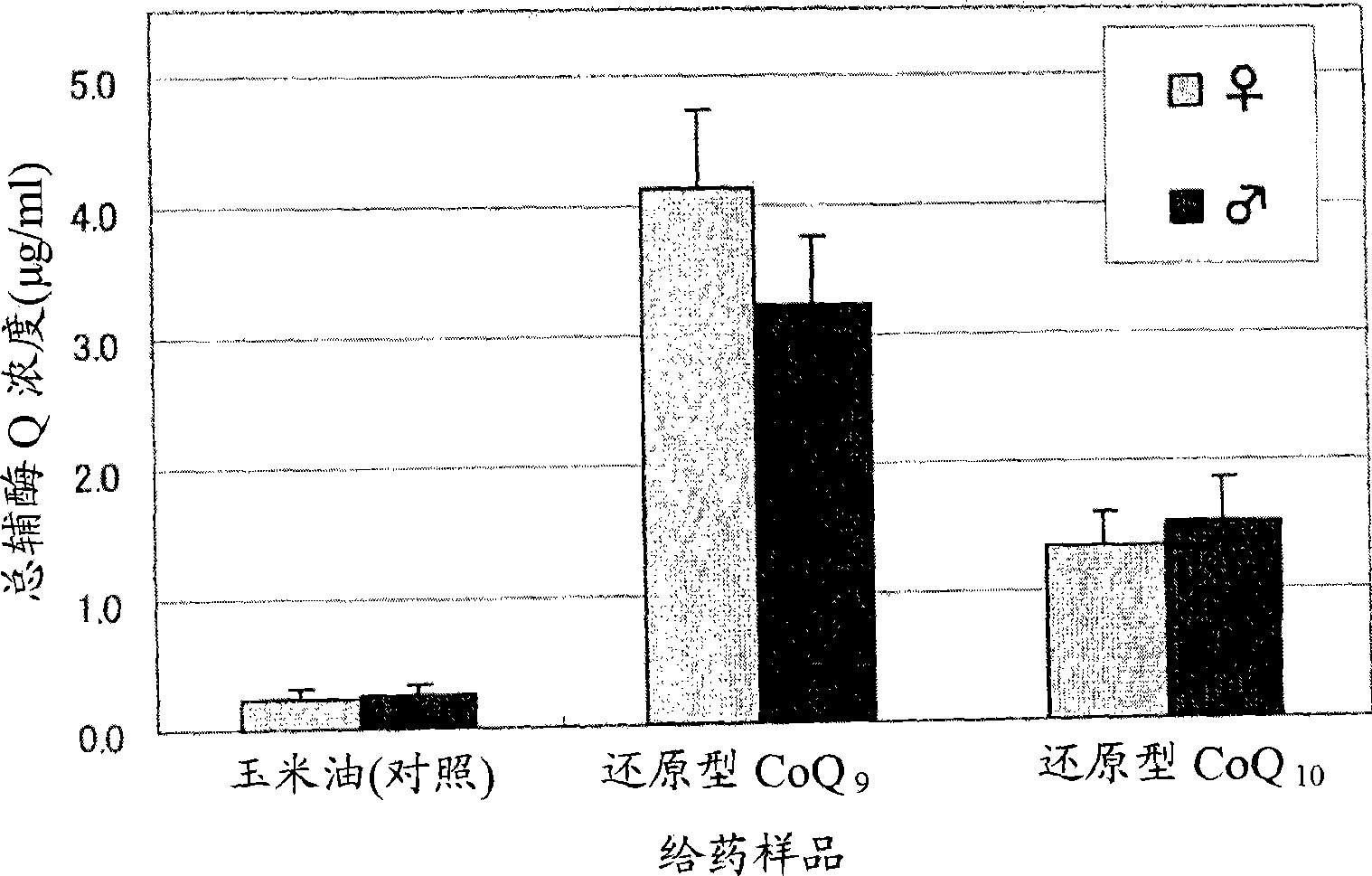Method for stabilization of reduced coenzyme Q10
A technology of reduced and oxidized coenzymes, applied in chemical instruments and methods, microcapsules, pharmaceutical formulations, etc., can solve the problem of high toxicity and achieve the effect of low possibility and high safety
- Summary
- Abstract
- Description
- Claims
- Application Information
AI Technical Summary
Problems solved by technology
Method used
Image
Examples
preparation example Construction
[0066] In addition, the preparation method of the present invention comprises containing oxidized coenzyme Q 9 (relative to oxidized coenzyme Q 10 not less than 0.6% by weight) and / or oxidized coenzyme Q 11 oxidized coenzyme Q 10 Steps to restore. Through this step, the reduced coenzyme Q containing coenzyme Q that coexists with (a) and / or (b) can finally be obtained 10 Compositions.
[0067] Of course, can contain oxidized coenzyme Q 9 and / or oxidized coenzyme Q 11 oxidized coenzyme Q 10 The reduction method (step) and the reduced coenzyme Q prepared separately 9 and / or reduced coenzyme Q11 The methods (steps) for adding are adopted in combination.
[0068] Co-existing reduced coenzyme Q described in the present invention 9 and / or reduced coenzyme Q 11 reduced coenzyme Q 10 The form of the composition is not particularly limited, and may be crystals; dissolved or suspended in a solvent; a melt at not lower than the melting point; or a form for administration to mam...
Embodiment
[0120] The present invention is illustrated in detail by the following examples, but is not limited thereto.
[0121] In an embodiment, reduced coenzyme Q 10 Purity, reduced coenzyme Q 10 and oxidized coenzyme Q 10 The weight ratio of is determined by HPLC analysis described below. However, the resulting reduced coenzyme Q 10 The purity does not limit the limit value of the purity of the present invention, the same, reduced coenzyme Q 10 and oxidized coenzyme Q 10 The weight ratio of reduced coenzyme Q in 10 The ratio does not limit its upper limit.
[0122] (HPLC analysis conditions)
[0123] Column: SYMMETRY C18 (manufactured by Waters) 250 mm (length) 4.6 mm (inner diameter), mobile phase: C 2 h 5 OH:CH 3 OH=4:3(v:v), detection wavelength: 210nm, flow rate: 1ml / min, reduced coenzyme Q 10 Retention time: 9.1min, oxidized coenzyme Q 10 Retention time: 13.3min.
preparation example 1
[0125] oxidized coenzyme Q 10 (100 g) and L-ascorbic acid (60 g) were added to 1000 g of ethanol, and the mixture was stirred at 78° C. to perform a reduction reaction. After 30 hours, the mixture was cooled to 50°C, and 400 g of ethanol was added maintaining the same temperature. This ethanol solution (containing 100g reduced coenzyme Q 10 ) was cooled to 2° C. with stirring at a cooling rate of 10° C. / hour to obtain a white slurry. The resulting slurry was filtered under reduced pressure, and the wet crystals were washed with cold ethanol, cold water, and cold ethanol in sequence (the temperature of the cold solvent used for washing was 2° C.), and dried under reduced pressure (20-40° C., 1- 30mmHg) to obtain white dry crystals (95g). All manipulations were performed under nitrogen atmosphere except drying under reduced pressure. Reduced coenzyme Q in the resulting crystals 10 / oxidized coenzyme Q 10 The weight ratio is 99.4 / 0.6.
PUM
 Login to View More
Login to View More Abstract
Description
Claims
Application Information
 Login to View More
Login to View More - R&D Engineer
- R&D Manager
- IP Professional
- Industry Leading Data Capabilities
- Powerful AI technology
- Patent DNA Extraction
Browse by: Latest US Patents, China's latest patents, Technical Efficacy Thesaurus, Application Domain, Technology Topic, Popular Technical Reports.
© 2024 PatSnap. All rights reserved.Legal|Privacy policy|Modern Slavery Act Transparency Statement|Sitemap|About US| Contact US: help@patsnap.com









